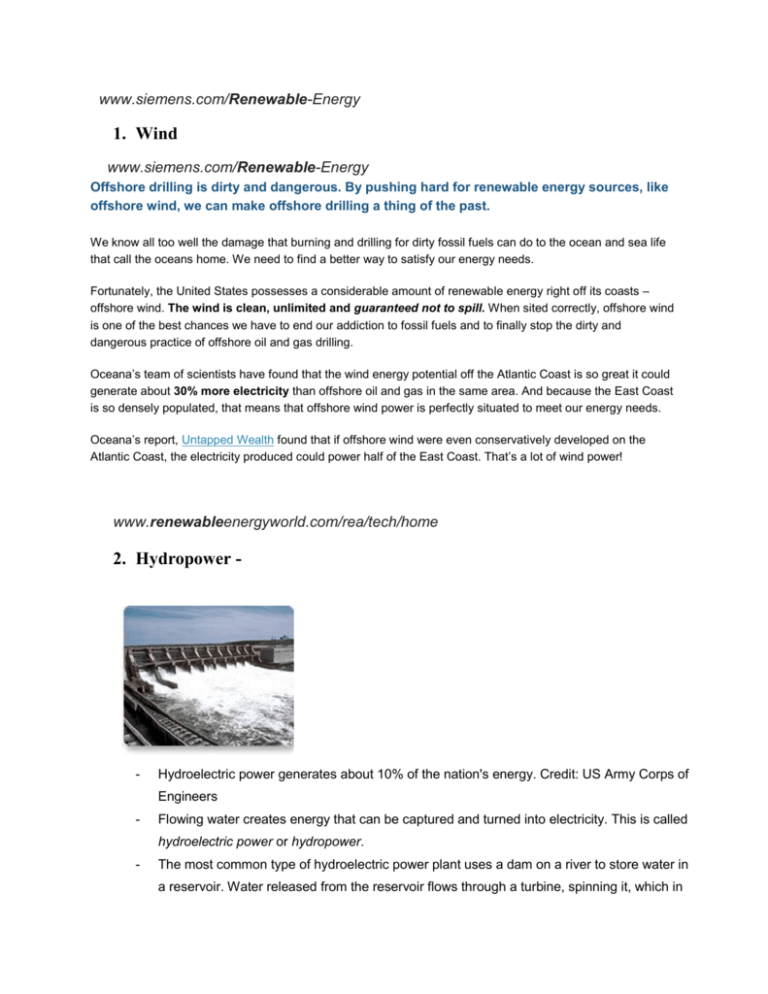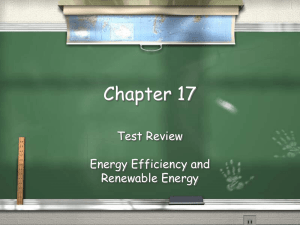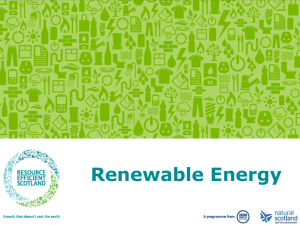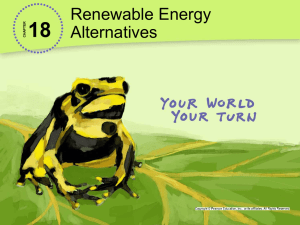Factual Information for the seven renewable
advertisement

www.siemens.com/Renewable-Energy 1. Wind www.siemens.com/Renewable-Energy Offshore drilling is dirty and dangerous. By pushing hard for renewable energy sources, like offshore wind, we can make offshore drilling a thing of the past. We know all too well the damage that burning and drilling for dirty fossil fuels can do to the ocean and sea life that call the oceans home. We need to find a better way to satisfy our energy needs. Fortunately, the United States possesses a considerable amount of renewable energy right off its coasts – offshore wind. The wind is clean, unlimited and guaranteed not to spill. When sited correctly, offshore wind is one of the best chances we have to end our addiction to fossil fuels and to finally stop the dirty and dangerous practice of offshore oil and gas drilling. Oceana’s team of scientists have found that the wind energy potential off the Atlantic Coast is so great it could generate about 30% more electricity than offshore oil and gas in the same area. And because the East Coast is so densely populated, that means that offshore wind power is perfectly situated to meet our energy needs. Oceana’s report, Untapped Wealth found that if offshore wind were even conservatively developed on the Atlantic Coast, the electricity produced could power half of the East Coast. That’s a lot of wind power! www.renewableenergyworld.com/rea/tech/home 2. Hydropower - - Hydroelectric power generates about 10% of the nation's energy. Credit: US Army Corps of Engineers - Flowing water creates energy that can be captured and turned into electricity. This is called hydroelectric power or hydropower. - The most common type of hydroelectric power plant uses a dam on a river to store water in a reservoir. Water released from the reservoir flows through a turbine, spinning it, which in turn activates a generator to produce electricity. But hydroelectric power doesn't necessarily require a large dam. Some hydroelectric power plants just use a small canal to channel the river water through a turbine. - Another type of hydroelectric power plant - called a pumped storage plant - can even store power. The power is sent from a power grid into the electric generators. The generators then spin the turbines backward, which causes the turbines to pump water from a river or lower reservoir to an upper reservoir, where the power is stored. To use the power, the water is released from the upper reservoir back down into the river or lower reservoir. This spins the turbines forward, activating the generators to produce electricity. - A small or micro-hydroelectric power system can produce enough electricity for a home, farm, or ranch 3. Solar Energy Solar energy technologies use the sun's energy and light to provide heat, light, hot water, electricity, and even cooling, for homes, businesses, and industry. There are a variety of technologies that have been developed to take advantage of solar energy. Solar Energy Technologies: Photovoltaic Systems Producing electricity directly from sunlight. Solar Hot Water Heating water with solar energy. Solar Electricity Using the sun's heat to produce electricity. Passive Solar Heating and Day lighting Using solar energy to heat and light buildings. Solar Process Space Heating and Cooling Industrial and commercial uses of the sun's heat. 4. Biomass Power We have used biomass energy or bioenergy - the energy from organic matter - for thousands of years, ever since people started burning wood to cook food or to keep warm. And today, wood is still our largest biomass energy resource. But many other sources of biomass can now be used, including plants, residues from agriculture or forestry, and the organic component of municipal and industrial wastes. Even the fumes from landfills can be used as a biomass energy source. The use of biomass energy has the potential to greatly reduce our greenhouse gas emissions. Biomass generates about the same amount of carbon dioxide as fossil fuels, but every time a new plant grows, carbon dioxide is actually removed from the atmosphere. The net emission of carbon dioxide will be zero as long as plants continue to be replenished for biomass energy purposes. These energy crops, such as fast-growing trees and grasses, are called biomass feedstocks. The use of biomass feedstocks can also help increase profits for the agricultural industry. There are three major biomass energy technology applications: Biofuels Converting biomass into liquid fuels for transportation. Biopower Burning biomass directly, or converting it into a gaseous fuel or oil, to generate electricity. Bioproducts Converting biomass into chemicals for making products that typically are made from petroleum 5. Ocean Energy Workers install equipment for an ocean thermal energy conversion experiment in 1994 at Hawaii's Natural Energy Laboratory. Credit: A. Resnick, Makai Ocean Engineering, Inc. The ocean can produce two types of energy: thermal energy from the sun's heat, and mechanical energy from the tides and waves. Oceans cover more than 70% of Earth's surface, making them the world's largest solar collectors. The sun's heat warms the surface water a lot more than the deep ocean water, and this temperature difference creates thermal energy. Just a small portion of the heat trapped in the ocean could power the world. Ocean thermal energy is used for many applications, including electricity generation. There are three types of electricity conversion systems: closed-cycle, open-cycle, and hybrid. Closedcycle systems use the ocean's warm surface water to vaporize a working fluid, which has a low-boiling point, such as ammonia. The vapor expands and turns a turbine. The turbine then activates a generator to produce electricity. Open-cycle systems actually boil the seawater by operating at low pressures. This produces steam that passes through a turbine/generator. And hybrid systems combine both closed-cycle and open-cycle systems. Ocean mechanical energy is quite different from ocean thermal energy. Even though the sun affects all ocean activity, tides are driven primarily by the gravitational pull of the moon, and waves are driven primarily by the winds. As a result, tides and waves are intermittent sources of energy, while ocean thermal energy is fairly constant. Also, unlike thermal energy, the electricity conversion of both tidal and wave energy usually involves mechanical devices. 6. Geothermal Energy The Earth's heat-called geothermal energy-escapes as steam at a hot springs in Nevada. Credit: Sierra Pacific Geothermal energy is the heat from the Earth. It's clean and sustainable. Resources of geothermal energy range from the shallow ground to hot water and hot rock found a few miles beneath the Earth's surface, and down even deeper to the extremely high temperatures of molten rock called magma. Almost everywhere, the shallow ground or upper 10 feet of the Earth's surface maintains a nearly constant temperature between 50° and 60°F (10° and 16°C). Geothermal heat pumps can tap into this resource to heat and cool buildings. A geothermal heat pump system consists of a heat pump, an air delivery system (ductwork), and a heat exchanger-a system of pipes buried in the shallow ground near the building. In the winter, the heat pump removes heat from the heat exchanger and pumps it into the indoor air delivery system. In the summer, the process is reversed, and the heat pump moves heat from the indoor air into the heat exchanger. The heat removed from the indoor air during the summer can also be used to provide a free source of hot water. In the United States, most geothermal reservoirs of hot water are located in the western states, Alaska, and Hawaii. Wells can be drilled into underground reservoirs for the generation of electricity. Some geothermal power plants use the steam from a reservoir to power a turbine/generator, while others use the hot water to boil a working fluid that vaporizes and then turns a turbine. Hot water near the surface of Earth can be used directly for heat. Direct-use applications include heating buildings, growing plants in greenhouses, drying crops, heating water at fish farms, and several industrial processes such as pasteurizing milk. Hot dry rock resources occur at depths of 3 to 5 miles everywhere beneath the Earth's surface and at lesser depths in certain areas. Access to these resources involves injecting cold water down one well, circulating it through hot fractured rock, and drawing off the heated water from another well. Currently, there are no commercial applications of this technology. Existing technology also does not yet allow recovery of heat directly from magma, the very deep and most powerful resource of geothermal energy. www.solarpowernotes.com/...energy/what-is-hybrid-renewable-energy.ht 7. Hybrid Renewable Energy Hybrid renewable energy source is becoming popular because it is composed of two or more energy sources. This combination of two energy sources is an efficient way of generating energy. Hybrid energy systems are used in remote areas for power generation. The use of hybrid power generations came forward due to the high prices of oil. The use of hybrid energy systems can optimize the power supply especially in rural areas. However it is still considered expensive and difficult to combine two or three energy sources together, but it is a one time expense. This one time expense can be of many uses to people living in remote areas. Hybrid energy is a combination of two or more energy sources for producing electricity. There are many sources of combining renewable energy sources to produce power but two of them are biomass wind fuel cell and photovoltaic wind. The first hybrid energy sources biomass wind fuel cell is a combination of 60% biomass and 20% wind power along with the derivation of energy from fuel cells. The hybrid energy sources can help farmers to run their tube wells to provide water to their irrigation land. Combining two or three energy sources to form one source is capable of generating efficient energy to power a house or a small industrial unit. The photovoltaic wind power is the combination of solar cells and wind turbines to generate electricity. The energy by wind turbines and solar panels is combined in a battery bank. It is then transformed to the inverter and then it helps in generating alternate current. The hybrid energy sources are much more cost effective and environment friendly. Hybrid energy sources can be used to generate electricity which can power many applications like TV, water pumps, grinders, irons and other machinery. Hybrid energy can also be used for supplying electricity to schools and churches which are located in remote areas. It can help the users to run electrical appliances as well as outdoor and indoor lights. These power systems can supply direct current and alternate current accordingly. The hybrid energy is useful only if we do not overlook the important considerations before deploying this energy.









